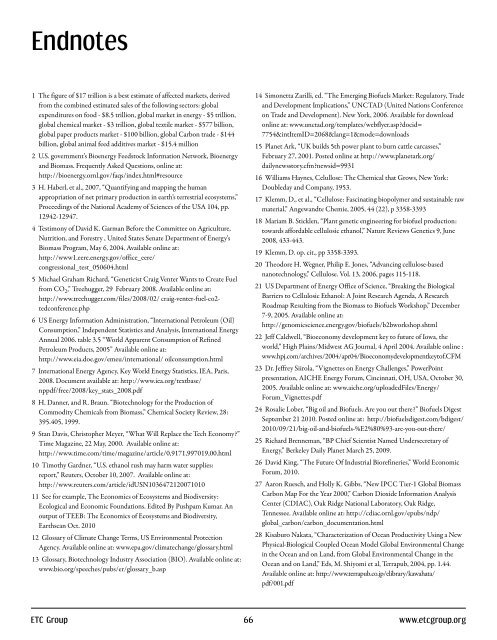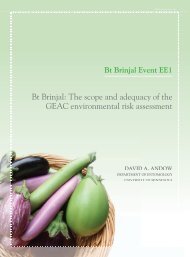English - pdf - 2145 Kb - Biosafety Information Centre
English - pdf - 2145 Kb - Biosafety Information Centre
English - pdf - 2145 Kb - Biosafety Information Centre
- No tags were found...
You also want an ePaper? Increase the reach of your titles
YUMPU automatically turns print PDFs into web optimized ePapers that Google loves.
Endnotes1 The figure of $17 trillion is a best estimate of affected markets, derivedfrom the combined estimated sales of the following sectors: globalexpenditures on food - $8.5 trillion, global market in energy - $5 trillion,global chemical market - $3 trillion, global textile market - $577 billion,global paper products market - $100 billion, global Carbon trade - $144billion, global animal feed additives market - $15.4 million2 U.S. government’s Bioenergy Feedstock <strong>Information</strong> Network, Bioenergyand Biomass. Frequently Asked Questions, online at:http://bioenergy.ornl.gov/faqs/index.html#resource3 H. Haberl, et al., 2007, “Quantifying and mapping the humanappropriation of net primary production in earth’s terrestrial ecosystems,”Proceedings of the National Academy of Sciences of the USA 104, pp.12942-12947.4 Testimony of David K. Garman Before the Committee on Agriculture,Nutrition, and Forestry , United States Senate Department of Energy'sBiomass Program, May 6, 2004. Available online at:http://www1.eere.energy.gov/office_eere/congressional_test_050604.html5 Michael Graham Richard, “Geneticist Craig Venter Wants to Create Fuelfrom CO 2 ,” Treehugger, 29 February 2008. Available online at:http://www.treehugger.com/files/2008/02/ craig-venter-fuel-co2-tedconference.php6 US Energy <strong>Information</strong> Administration, “International Petroleum (Oil)Consumption,” Independent Statistics and Analysis, International EnergyAnnual 2006. table 3.5 “World Apparent Consumption of RefinedPetroleum Products, 2005” Available online at:http://www.eia.doe.gov/emeu/international/ oilconsumption.html7 International Energy Agency, Key World Energy Statistics, IEA, Paris,2008. Document available at: http://www.iea.org/textbase/np<strong>pdf</strong>/free/2008/key_stats_2008.<strong>pdf</strong>8 H. Danner, and R. Braun. “Biotechnology for the Production ofCommodity Chemicals from Biomass,” Chemical Society Review, 28:395.405, 1999.9 Stan Davis, Christopher Meyer, “What Will Replace the Tech Economy?”Time Magazine, 22 May, 2000. Available online at:http://www.time.com/time/magazine/article/0,9171,997019,00.html10 Timothy Gardner, “U.S. ethanol rush may harm water supplies:report,” Reuters, October 10, 2007. Available online at:http://www.reuters.com/article/idUSN103647212007101011 See for example, The Economics of Ecosystems and Biodiversity:Ecological and Economic Foundations. Edited By Pushpam Kumar. Anoutput of TEEB: The Economics of Ecosystems and Biodiversity,Earthscan Oct. 201012 Glossary of Climate Change Terms, US Environmental ProtectionAgency. Available online at: www.epa.gov/climatechange/glossary.html13 Glossary, Biotechnology Industry Association (BIO). Available online at:www.bio.org/speeches/pubs/er/glossary_b.asp14 Simonetta Zarilli, ed. “The Emerging Biofuels Market: Regulatory, Tradeand Development Implications,” UNCTAD (United Nations Conferenceon Trade and Development). New York, 2006. Available for downloadonline at: www.unctad.org/templates/webflyer.asp?docid=7754&intItemID=2068&lang=1&mode=downloads15 Planet Ark, “UK builds 5th power plant to burn cattle carcasses,”February 27, 2001. Posted online at http://www.planetark.org/dailynewsstory.cfm?newsid=993116 Williams Haynes, Celullose: The Chemical that Grows, New York:Doubleday and Company, 1953.17 Klemm, D., et al., “Cellulose: Fascinating biopolymer and sustainable rawmaterial,” Angewandte Chemie, 2005, 44 (22), p 3358-339318 Mariam B. Sticklen, “Plant genetic engineering for biofuel production:towards affordable cellulosic ethanol,” Nature Reviews Genetics 9, June2008, 433-443.19 Klemm, D. op. cit., pp 3358-3393.20 Theodore H. Wegner, Philip E. Jones, “Advancing cellulose-basednanotechnology,” Cellulose. Vol. 13, 2006, pages 115-118.21 US Department of Energy Office of Science, “Breaking the BiologicalBarriers to Cellulosic Ethanol: A Joint Research Agenda, A ResearchRoadmap Resulting from the Biomass to Biofuels Workshop,” December7-9, 2005. Available online at:http://genomicscience.energy.gov/biofuels/b2bworkshop.shtml22 Jeff Caldwell, “Bioeconomy development key to future of Iowa, theworld,” High Plains/Midwest AG Journal, 4 April 2004. Available online :www.hpj.com/archives/2004/apr04/Bioeconomydevelopmentkeytof.CFM23 Dr. Jeffrey Siirola, “Vignettes on Energy Challenges,” PowerPointpresentation, AICHE Energy Forum, Cincinnati, OH, USA, October 30,2005. Available online at: www.aiche.org/uploadedFiles/Energy/Forum_Vignettes.<strong>pdf</strong>24 Rosalie Lober, “Big oil and Biofuels. Are you out there?” Biofuels DigestSeptember 21 2010. Posted online at: http://biofuelsdigest.com/bdigest/2010/09/21/big-oil-and-biofuels-%E2%80%93-are-you-out-there/25 Richard Brenneman, “BP Chief Scientist Named Undersecretary ofEnergy,” Berkeley Daily Planet March 25, 2009.26 David King, “The Future Of Industrial Biorefineries,” World EconomicForum, 2010.27 Aaron Ruesch, and Holly K. Gibbs, “New IPCC Tier-1 Global BiomassCarbon Map For the Year 2000,” Carbon Dioxide <strong>Information</strong> AnalysisCenter (CDIAC), Oak Ridge National Laboratory, Oak Ridge,Tennessee. Available online at: http://cdiac.ornl.gov/epubs/ndp/global_carbon/carbon_documentation.html28 Kisaburo Nakata, “Characterization of Ocean Productivity Using a NewPhysical-Biological Coupled Ocean Model Global Environmental Changein the Ocean and on Land, from Global Environmental Change in theOcean and on Land,” Eds, M. Shiyomi et al, Terrapub, 2004, pp. 1.44.Available online at: http://www.terrapub.co.jp/elibrary/kawahata/<strong>pdf</strong>/001.<strong>pdf</strong>ETC Group 66 www.etcgroup.org











